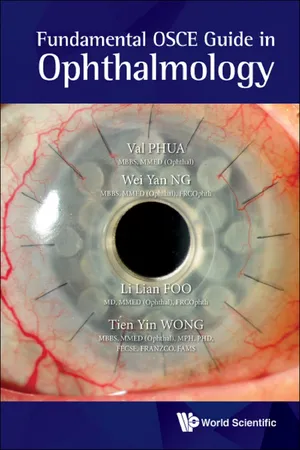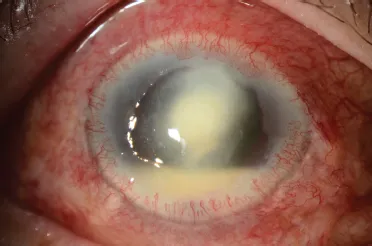
- 160 pages
- English
- ePUB (mobile friendly)
- Available on iOS & Android
Fundamental OSCE Guide in Ophthalmology
About this book
In our world of information overload, there is an increasing struggle to keep the main thing the main thing. Fundamental OSCE Guide in Ophthalmology is a concise study guide presented in a direct, exam style question and answer format, illustrated with high quality clinically relevant photographs tailored to medical students, nurses, optometrists and residents in their early ophthalmology training.
This book provides invaluable guidance to readers in presenting their answers in a logical, succinct and elegant manner. The style and format have been intentionally designed to simulate examination conditions and to provide readers with ample practice in preparation for the examinations.
Ophthalmology is a very specialized field with many textbooks providing a wealth of information. Exposure to ophthalmology is limited in most undergraduate interactions to a few weeks at best. With a shortage of time, gaining a good understanding of what is important is overwhelming. This book helps to streamline and focus knowledge of readers in understanding the essential conditions in ophthalmology.
Various other texts on ophthalmology are often in prose and covers a wide range of topics, including the esoteric conditions. To the untrained eye, it is difficult to discern what should be focused on. Students are often times excited about knowing rare conditions and spend precious time and effort remembering details of these conditions without a strong foundation of the more common conditions seen day to day. This books not only highlights the important conditions, it is structured to simulate examination conditions and can be used as a self-testing tool.
Contents:
- About the Authors
- List of Contributors
- Cornea
- Glaucoma
- Retina
- Uveitis
- Neuro-Ophthalmology
- Oculoplastics
- Paediatrics
- Imaging
- Index
Readership: Medical students, nurses, optometrists and residents in their early ophthalmology training. OSCE;Study;Guide;Ophthalmology00
Frequently asked questions
- Essential is ideal for learners and professionals who enjoy exploring a wide range of subjects. Access the Essential Library with 800,000+ trusted titles and best-sellers across business, personal growth, and the humanities. Includes unlimited reading time and Standard Read Aloud voice.
- Complete: Perfect for advanced learners and researchers needing full, unrestricted access. Unlock 1.4M+ books across hundreds of subjects, including academic and specialized titles. The Complete Plan also includes advanced features like Premium Read Aloud and Research Assistant.
Please note we cannot support devices running on iOS 13 and Android 7 or earlier. Learn more about using the app.
Information

CORNEA
| 1. | A 24-year-old contact lens wearer comes in with a two-day history of eye pain. |

| Q | 1.1 What else do you want to know about in the history? |
| Q | 1.2 What are the signs? |
| Q | 1.3 What are your differential diagnoses? |
| Q | 1.4 How do you manage the above patient? |
| Q | 1.5 What do you send the corneal scrapings for? |
| Q | 1.6 What are the complications of a corneal ulcer? |
| 2. | A 20... |
Table of contents
- Cover Page
- Title Page
- Copyright Page
- Contents
- About the Authors
- List of Contributors
- 1. Cornea
- 2. Glaucoma
- 3. Retina
- 4. Uveitis
- 5. Neuro-Ophthalmology
- 6. Oculoplastics
- 7. Paediatrics
- 8. Imaging
- Index